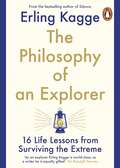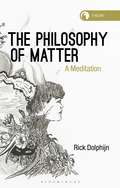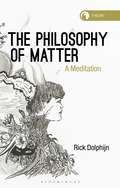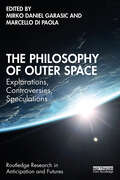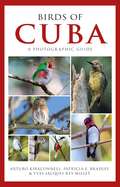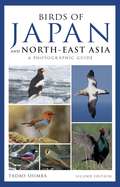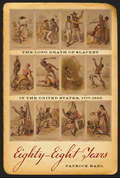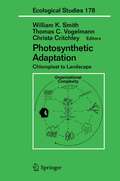- Table View
- List View
The Philosophy of an Explorer: 16 Life-lessons from Surviving the Extreme
by Erling Kagge'Erling Kagge transforms and consoles us' Alain de Botton ____________________________Surviving extreme conditions can teach us to lead a fulfilled life. No one knows this better than Erling Kagge, who was the first man in history to reach all of the Earth's poles by foot - the North, the South, and the summit of Everest. In Philosophy for Polar Explorers he brings together the wisdom and expertise he has gained from the expeditions that have taken him to the limits of the earth, and of human endurance.In sixteen meditative but practical lessons - from cultivating an optimistic outlook, to getting up at the right time, to learning to take pleasure in the small things and comfort in solitude - Erling Kagge reveals what survival in the most extreme conditions can teach us about how to lead a meaningful life. Wherever we may be headed. ____________________________'His wisdom will soothe and awaken' Fearne Cotton'A delightful book that explores the strange land between getting out of bed in the morning and reaching for the moon Tristan Gooley'A wonderfully deft Swiss army knife of a book' Dan Richards'As an explorer Erling Kagge is world class; as a writer he is equally gifted' Sir Ranulph Fiennes 'Erling Kagge is a philosophical adventurer - or perhaps an adventurous philosopher' The New York Times'An author for our noisy times, full of a rare and deeply redemptive languor and perspective' Alain de Botton
The Philosophy of Geography (Springer Geography)
by Timothy Tambassi Marcello TancaThe relationship between geography and philosophy is still largely in need of being explored. Geographers and philosophers share the responsibility for that. On the one hand, geographers have considered as a dangerous deviation any attempt to elaborate an image of the Earth which was not a mere replica of a cartographic representation. On the other hand, philosophers have generally been uninterested in a discipline offering little chance for critical reflection. In light of these considerations, the purpose of this book is to identify some fundamental philosophical issues involved in the reflection of geography by adopting a perspective which looks at the discipline with a specific focus on its fundamental concepts and distinctions.
The Philosophy of Matter: A Meditation (Theory in the New Humanities)
by Rick DolphijnThe Philosophy of Matter is a journey in thinking through the material fate of the earth itself; its surfaces and undercurrrents, ecologies, environments and irreparable cracks. With figures such as Spinoza, Gilles Deleuze and Michel Serres as philosophical guides and writings on New Materialism, Posthumanism and Affect Theory as intellectual context, Rick Dolphijn proposes a radical rethinking of some of the basic themes of philosophy: subjectivity, materiality, body (both human and otherwise) and the act of living. This rethink is a work of imagination and meditation in order to conceive of “another earth for another people”. It is a homage to courageous thinking that dares to question the religious, capitalist and humanist realities of the day.A poetic philosophy of how to live in troubling times when even the earth beneath us feels unstable, Dolphijn offers a way to think about the world with depth, honesty and glimpses of hope.
The Philosophy of Matter: A Meditation (Theory in the New Humanities)
by Rick DolphijnThe Philosophy of Matter is a journey in thinking through the material fate of the earth itself; its surfaces and undercurrrents, ecologies, environments and irreparable cracks. With figures such as Spinoza, Gilles Deleuze and Michel Serres as philosophical guides and writings on New Materialism, Posthumanism and Affect Theory as intellectual context, Rick Dolphijn proposes a radical rethinking of some of the basic themes of philosophy: subjectivity, materiality, body (both human and otherwise) and the act of living. This rethink is a work of imagination and meditation in order to conceive of “another earth for another people”. It is a homage to courageous thinking that dares to question the religious, capitalist and humanist realities of the day.A poetic philosophy of how to live in troubling times when even the earth beneath us feels unstable, Dolphijn offers a way to think about the world with depth, honesty and glimpses of hope.
Philosophy of Nature: Rethinking naturalness (Routledge Explorations in Environmental Studies)
by Svein Anders LieThe concept of naturalness has largely disappeared from the academic discourse in general but also the particular field of environmental studies. This book is about naturalness in general – about why the idea of naturalness has been abandoned in modern academic discourse, why it is important to explicitly re-establish some meaning for the concept and what that meaning ought to be. Arguing that naturalness can and should be understood in light of a dispositional ontology, the book offers a point of view where the gap between instrumental and ethical perspectives can be bridged. Reaching a new foundation for the concept of ‘naturalness’ and its viability will help raise and inform further discussions within environmental philosophy and issues occurring in the crossroads between science, technology and society. This topical book will be of great interest to researchers and students in Environmental Studies, Environmental Philosophy, Science and Technology Studies, Conservation Studies as well as all those generally engaged in debates about the place of ‘man in nature’.
Philosophy of Nature: Rethinking naturalness (Routledge Explorations in Environmental Studies)
by Svein Anders LieThe concept of naturalness has largely disappeared from the academic discourse in general but also the particular field of environmental studies. This book is about naturalness in general – about why the idea of naturalness has been abandoned in modern academic discourse, why it is important to explicitly re-establish some meaning for the concept and what that meaning ought to be. Arguing that naturalness can and should be understood in light of a dispositional ontology, the book offers a point of view where the gap between instrumental and ethical perspectives can be bridged. Reaching a new foundation for the concept of ‘naturalness’ and its viability will help raise and inform further discussions within environmental philosophy and issues occurring in the crossroads between science, technology and society. This topical book will be of great interest to researchers and students in Environmental Studies, Environmental Philosophy, Science and Technology Studies, Conservation Studies as well as all those generally engaged in debates about the place of ‘man in nature’.
The Philosophy of Outer Space: Explorations, Controversies, Speculations (Routledge Research in Anticipation and Futures)
by Mirko Daniel Garasic Marcello Di PaolaThis volume provides a rigorous philosophical investigation of the rationales, challenges, and promises of the coming Space Age.Over the past decade, space exploration has made significant and accelerating progress, and its potential has attracted growing attention from science, states, businesses, innovators, as well as the media and society more generally. Yet philosophical theorizing concerning the premises, values, meanings, and impacts of space exploration is still in its infancy, and this potentially immense field of study is far from mainstream yet. This book advances outer space philosophy by integrating key scientific and societal debates sparked by recent developments in space research and activities with conceptual, existential, ethical, aesthetic, and political themes and concerns. It maps various regions of philosophical exploration, reflection, and speculation regarding humanity’s present and future emanations into outer space, to promote a broad, rich, and nuanced societal debate regarding this transformative enterprise, which is as stimulating as it can be disorienting.This book will be a fascinating read for academics, researchers, and students interested in philosophy, space studies, science and technology studies, future studies, and sustainability.
The Philosophy of Outer Space: Explorations, Controversies, Speculations (Routledge Research in Anticipation and Futures)
This volume provides a rigorous philosophical investigation of the rationales, challenges, and promises of the coming Space Age.Over the past decade, space exploration has made significant and accelerating progress, and its potential has attracted growing attention from science, states, businesses, innovators, as well as the media and society more generally. Yet philosophical theorizing concerning the premises, values, meanings, and impacts of space exploration is still in its infancy, and this potentially immense field of study is far from mainstream yet. This book advances outer space philosophy by integrating key scientific and societal debates sparked by recent developments in space research and activities with conceptual, existential, ethical, aesthetic, and political themes and concerns. It maps various regions of philosophical exploration, reflection, and speculation regarding humanity’s present and future emanations into outer space, to promote a broad, rich, and nuanced societal debate regarding this transformative enterprise, which is as stimulating as it can be disorienting.This book will be a fascinating read for academics, researchers, and students interested in philosophy, space studies, science and technology studies, future studies, and sustainability.
Phosphate in Soils: Interaction with Micronutrients, Radionuclides and Heavy Metals (Advances in Trace Elements in the Environment)
by H. Magdi SelimEdited by One of the Best Specialists in Soil Science Recent studies reveal that Phosphorus (P) in the form of phosphate, a macronutrient essential for plant growth, and crop yields can influence the bioavailability, retention, and mobility of trace elements, metal(loid)s, and radio nuclides in soils. When this occurs, phosphates can affect the dynamics of heavy metals and influence soil characteristics, impacting soil mobility and toxicity. Phosphate in Soils: Interaction with Micronutrients, Radionuclides and Heavy Metals utilizes the latest research to emphasize the role that phosphate plays in enhancing or reducing the mobility of heavy metals in soil, and the soil-water-plant environment. It provides an in-depth understanding of each heavy metal species, and expands on phosphate interactions in geological material. Composed of 12 chapters, this text: Provides an overview of the reactions of metal(loid)s and common P compounds that are used as fertilizer in soils Emphasizes the effect of phosphorus on copper and zinc adsorption in acid soils Discusses findings on the influence of phosphate compounds on speciation, mobility, and bioavailability of heavy metals in soils as well as the role of phosphates on in situ and phytoremediation of heavy metals for contaminated soils Places emphasis on the influence of phosphate on various heavy metals species in soils, and their solubility/mobility and availability Provides extensive information on testing various high phosphate materials for remediation of heavy metal, micronutrients, and radionuclides contaminated sites Explores the reactivity of heavy metals, micronutrients and radionuclides elements in several soils Presents a case study illustrating various remediation efforts of acidic soils and remediation of Cu, Zn, and lead (Pb) contaminated soils around nonferrous industrial plants Emphasizes the significance of common ions (cations and anions) on phosphate mobility and sorption in soils, and more The author includes analytical and numerical solutions along with hands-on applications, and addresses other topics that include the transport and sorption modeling of heavy metals in the presence of phosphate at different scales in the vadose zone.
Phosphor-Dynamiken in Böden: Grundlagen, Konzepte und Untersuchungen zur räumlichen Verteilung des Nährstoffs
by Christoph WeihrauchDie vorliegende Studie zeigt, dass der Nährstoff Phosphor in Böden und Landschaften sehr ungleichmäßig verteilt ist. Dies wird auf seine unterirdische Verlagerung zurückgeführt. Die Ergebnisse von Christoph Weihrauch verdeutlichen damit, dass ein Umdenken bezüglich Phosphor in Böden nötig ist. Die Verlagerung dieses Nährstoffs hat vor allem Konsequenzen für die Düngung in der Landwirtschaft. Dort wird die ungleichmäßige Phosphor-Verbreitung bislang nicht in die Düngerplanung einbezogen, sodass Äcker teilweise über- bzw. unterversorgt werden. Dadurch wird viel Phosphor verschwendet, obwohl die notwendigen Rohstoffe bereits knapp werden. Noch in diesem Jahrhundert könnte daraus eine „Phosphor-Krise“ mit globalen Hungersnöten erwachsen. Diese Studie gibt Impulse dafür, wie Phosphor-Dünger ressourcenschonend, effizient und ohne Umweltbelastungen genutzt werden können. Damit leistet sie einen Beitrag dazu, die drohende „Phosphor-Krise“ abzuwenden.
Phosphorus in Action: Biological Processes in Soil Phosphorus Cycling (Soil Biology #26)
by Else Bünemann, Astrid Oberson and Emmanuel FrossardPhosphorus (P) is a finite resource which is essential for life. It is a limiting nutrient in many ecosystems but also a pollutant which can affect biodiversity in terrestrial ecosystems and change the ecology of water bodies. This book collects the latest information on biological processes in soil P cycling, which to date have remained much less understood than physico-chemical processes. The methods section presents spectroscopic techniques and the characterization of microbial P forms, as well as the use of tracers, molecular approaches and modeling of soil-plant systems. The section on processes deals with mycorrhizal symbioses, microbial P solubilization, soil macrofauna, phosphatase enzymes and rhizosphere processes. On the system level, P cycling is examined for grasslands, arctic and alpine soils, forest plantations, tropical forests, and dryland regions. Further, P management with respect to animal production and cropping, and the interactions between global change and P cycling, are treated.
Phosphorus in Freshwater Ecosystems: Proceedings of a Symposium held in Uppsala, Sweden, 25–28 September 1985 (Developments in Hydrobiology #48)
by Gunnar Persson Mats JanssonProceedings of a symposium held in Uppsala, Sweden, September 25-28, 1985
A Photographic Guide to Seashore Life in the North Atlantic: Canada to Cape Cod
by J. Duane SeptThe tides of the North Atlantic are the world's highest, and they reveal a world of amazing seashore life--from jellies and sea anemones, to clams and crabs, to seaweeds and lichens. With some 300 crisp, vibrant color photographs and brief, precise descriptions, this field guide makes it easier than ever to identify Atlantic seashore life from Canada to Cape Cod. Duane Sept covers more than 225 common intertidal species found on rocky shores, sandy shores, mud beaches, and floating docks, and explains the natural history of these specialized organisms. He also describes tidal habitats, tells how to explore the seashore in a safe and environmentally responsible way, and provides extensive information on some of the best places in the North Atlantic to view seashore life. Both casual and dedicated beachcombers will find this a handy, enjoyable, and reliable guide. The first full-color photographic guide to North Atlantic seashore life Includes some 300 color photographs and illustrations Makes species identification quick and easy Covers more than 225 common intertidal species found from Canada to Cape Cod Covers rocky shores, sandy shores, mud beaches, and floating docks Tells how to explore safely and in an environmentally responsible way Provides extensive information on some of the best places to visit in the Atlantic Northeast
Photographic Guide to the Birds of Cuba
by Arturo Kirkconnell Patricia E. Bradley Yves-Jacques Rey-MilletCuba is now one of the most popular birding destinations in the world. Its rich avifauna includes 25 endemic species, and the island is also home to a range of regional scarcities and an important stopping point for migrants as they cross the Caribbean. Containing hundreds of stunning photographs by Yves-Jacques Rey-Millet, A Photographic Guide to the Birds of the Cuba, the latest addition to Helm's Photographic Guides series, provides full photographic coverage of every species on the Cuban list. Concise text for each species includes identification, similar species, voice, habitats and behaviour, status and distribution, along with a map. This guide is an essential companion for any birder or naturalist visiting this beautiful and bird-rich island.
Photographic Guide to the Birds of Cuba
by Arturo Kirkconnell Patricia E. Bradley Yves-Jacques Rey-MilletCuba is now one of the most popular birding destinations in the world. Its rich avifauna includes 25 endemic species, and the island is also home to a range of regional scarcities and an important stopping point for migrants as they cross the Caribbean. Containing hundreds of stunning photographs by Yves-Jacques Rey-Millet, A Photographic Guide to the Birds of the Cuba, the latest addition to Helm's Photographic Guides series, provides full photographic coverage of every species on the Cuban list. Concise text for each species includes identification, similar species, voice, habitats and behaviour, status and distribution, along with a map. This guide is an essential companion for any birder or naturalist visiting this beautiful and bird-rich island.
Photographic Guide to the Birds of Japan and North-east Asia
by Tadao ShimbaEastern Asia is blessed with a rich and spectacular avifauna, and all 520 regularly occurring species are featured in this spectacular and lavish new photographic guide to the region, covering Japan, northern China, North and South Korea and the Russian Far East. The concise text focuses on key identification criteria, and is accompanied by a distribution map for every species. The accompanying photographs, contributed by Japan's top bird photographers, form a stunning series that will allow both field identification and rich enjoyment at home afterwards. This beautiful book is a must-have for anyone interested in the birds of Asia.
Photographic Guide to the Birds of Japan and North-east Asia: Improvisation And The Theatre (Bloomsbury Revelations Ser.)
by Tadao ShimbaEastern Asia is blessed with a rich and spectacular avifauna, and all 520 regularly occurring species are featured in this spectacular and lavish new photographic guide to the region, covering Japan, northern China, North and South Korea and the Russian Far East. The concise text focuses on key identification criteria, and is accompanied by a distribution map for every species. The accompanying photographs, contributed by Japan's top bird photographers, form a stunning series that will allow both field identification and rich enjoyment at home afterwards. This beautiful book is a must-have for anyone interested in the birds of Asia.
Photographing the Elements: Capturing Nature's Most Extreme Phenomena With Your Digital Camera
by Gary Eastwood Joseph MeehanBlizzards, tornados, volcanic eruptions, and desert sandstorms? Forget about seeking shelter - these are the prime times to grab your gear and get one-of-a-kind photographs of the most exotic and extraordinary subjects on earth. Miles away from your typical landscape and nature shots, these powerful images are a stunning survey of natural wonders, a vibrant addition to any portfolio, and a testament to the adventurous spirit of the extreme photographer. Get out of your comfort zone and embrace the elements!
Photography, Ecology and Historical Change in the Anthropocene: Activating Archives (Photography, Place, Environment)
by Bergit ArendsMoving beyond existing scholarship, this book connects photography, archives, ecology and historical change and critically applies the Anthropocene as framework to the in-depth study of artists’ projects. It discards single modes of seeing environmental transformations in favour of a multiple and de-centred environmental imagination.Bergit Arends uses multidisciplinary perspectives to view localized environmental, social and political issues through research-based artistic practices. The book not only makes available original research into newly and recently discovered archives of ecological and historical change but also shows how this research is manifest in exhibition formats. This book presents international, transhistorical projects by contemporary visual artists who use archives together with photography as documentary and performative media for the comparative study of environments and places. A wide array of artists from diverse backgrounds working primarily in Europe and North America from the 1970s to the present day are discussed and set in relation to Anthropocene narratives. Case studies include environmental archive-based work by Nguyen the Thuc, Christiane Eisler, Chrystel Lebas, Mark Dion, Joy Gregory and Philip Miller.The book will be of interest to scholars working in photography, archive studies, art history, visual culture, environmental humanities and ecocriticism.
Photography, Ecology and Historical Change in the Anthropocene: Activating Archives (Photography, Place, Environment)
by Bergit ArendsMoving beyond existing scholarship, this book connects photography, archives, ecology and historical change and critically applies the Anthropocene as framework to the in-depth study of artists’ projects. It discards single modes of seeing environmental transformations in favour of a multiple and de-centred environmental imagination.Bergit Arends uses multidisciplinary perspectives to view localized environmental, social and political issues through research-based artistic practices. The book not only makes available original research into newly and recently discovered archives of ecological and historical change but also shows how this research is manifest in exhibition formats. This book presents international, transhistorical projects by contemporary visual artists who use archives together with photography as documentary and performative media for the comparative study of environments and places. A wide array of artists from diverse backgrounds working primarily in Europe and North America from the 1970s to the present day are discussed and set in relation to Anthropocene narratives. Case studies include environmental archive-based work by Nguyen the Thuc, Christiane Eisler, Chrystel Lebas, Mark Dion, Joy Gregory and Philip Miller.The book will be of interest to scholars working in photography, archive studies, art history, visual culture, environmental humanities and ecocriticism.
Photoreceptors and Calcium (Advances in Experimental Medicine and Biology #514)
by Wolfgang Baehr Krzysztof PalczewskiPhotosynthetic Adaptation: Chloroplast to Landscape (Ecological Studies #178)
by William K. Smith Thomas C. Vogelmann Christa CritchleyThis is a thorough study of photosynthetic mechanisms from cells to leaves, crown, and canopy. The authors question whether photosynthetic adaptations take place primarily at the metabolic and biochemical level or through changes in structure and form, or both. The text goes on to analyze the relative importance of genes that control metabolic and light reactions, and the structure, arrangement, and orientation of photosynthesis.
Phthalate Esters (The Handbook of Environmental Chemistry #3Q)
by Charles StaplesPhthalate esters are an important class of chemicals widely used in commercial applications, primarily as plasticizers to soften vinyl, but they are also used in consumer products. This book reviews the state of the scientific knowledge of phthalate esters in the environment. Key information reported includes: analytical methodologies; a compilation of concentration measurements in water, sediment, soil, air, dust, and food; plus an assessment of critical exposure pathways. In addition, key physical properties data and fate characteristics that control exposure are reviewed. Also included are pertinent ecotoxicity data and mammalian toxicity and human health information. Finally, the monograph addresses potential environmental risks.
Phylogenetic Diversity: Applications and Challenges in Biodiversity Science
by Rosa A. Scherson Daniel P. Faith“Biodiversity” refers to the variety of life. It is now agreed that there is a “biodiversity crisis”, corresponding to extinction rates of species that may be 1000 times what is thought to be “normal”. Biodiversity science has a higher profile than ever, with the new Intergovernmental Science-Policy Platform on Biodiversity and Ecosystem Services involving more than 120 countries and 1000s of scientists. At the same time, the discipline is re-evaluating its foundations – including its philosophy and even core definitions. The value of biodiversity is being debated. In this context, the tree of life (“phylogeny”) is emerging as an important way to look at biodiversity, with relevance cutting across current areas of concern – from the question of resilience within ecosystems, to conservation priorities for globally threatened species – while capturing the values of biodiversity that have been hard to quantify, including resilience and maintaining options for future generations.This increased appreciation of the importance of conserving “phylogenetic diversity”, from microbial communities in the human gut to global threatened species, has inevitably resulted in an explosion of new indices, methods, and case studies. This book recognizes and responds to the timely opportunity for synthesis and sharing experiences in practical applications. The book recognizes that the challenge of finding a synthesis, and building shared concepts and a shared toolbox, requires both an appreciation of the past and a look into the future. Thus, the book is organized as a flow from history, concepts and philosophy, through to methods and tools, and followed by selected case studies. A positive vision and plan of action emerges from these chapters, that includes coping with inevitable uncertainties, effectively communicating the importance of this “evolutionary heritage” to the public and to policy-makers, and ultimately contributing to biodiversity conservation policy from local to global scales.
Phylogenetics of Bees
by Rustem Abuzarovich Ilyasov Hyung Wook KwonBees are flying insects of the order Hymenoptera closely related to wasps and ants. The ancestors of bees are assumed to be predatory wasps, which switched to pollen consumption. Further, bees co-evolved with flowering plants and divided into several species according to climatic conditions. Widely known bees are western bees Apis mellifera, and eastern bees Apis cerana. This book sheds light on features of evolution, phylogenesis, speciation, adaptation to environment, and taxonomy of bees. It will be of particular relevance to evolutionists, geneticists, taxonomists, ecologists, population geneticist, and breeders.
